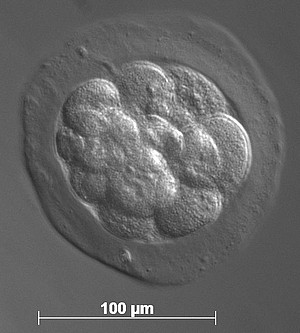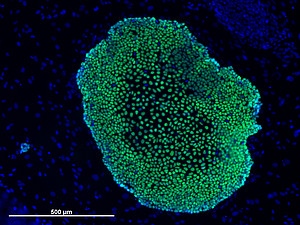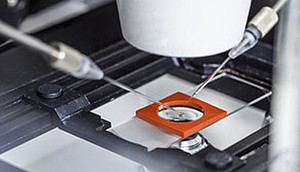At the German Primate Center, the Stem Cell Biology Unit does research on the „jack of all trades“ stem cells.
The human body contains a number of different cell types, such as nerve cells, skin cells and the phagocytes of the immune system. In the organisms, they fulfil specific tasks and according to their function, they have different properties. The development of a cell to a specific type is also known as differentiation. Naturally, this process is irreversible. Differentiated cells can therefore normally not develop into other cell types.
In contrast to differentiated cells, stem cells are still undifferentiated. However, they have the potential - depending on the type of stem cell - to develop into one, several or all the differentiated cell types found in the adult body. In addition to the fact that stem cells are still undifferentiated, a further characteristic feature of stem cells is that they can regenerate themselves over a longer period.
Types of stem cells

Photo: Edgar Vogt
There are various types of stem cells: pluripotent, multipotent and unipotent stem cells. The difference between the three types lies in the amount of the different types of daughter cells they can produce.
The main characteristic of pluripotent stem cells is that all the differentiated cells can form an adult organism. The pluripotent stem cells are embryonic stem cells and induced pluripotent stem cells.
Embryonic stem cells are taken from embryos in the early stages. They also maintain the property of the “progenitor cells” of the embryo in cell culture that can develop into any type of cells in the adult body. Inspired by this unique ability of pluripotent stem cells, the idea to differentiate pluripotent stem cells in the laboratory to clinically important cell types such as heart muscle cells and nerve cells that could be used for the treatment of patients, was born. However, for the research with embryonic stem cells, embryos must be used. Therefore, research with human embryonic stem cells is ethically controversial, and German law prohibits the production of new embryonic stem cells.
A very exciting as well as a potentially very promising alternative for future clinical application to embryonic stem cells are induced pluripotent stem cells. They are obtained by the “reprogramming” of ethically acceptable adult cells, e.g. from the connective tissue cells from the skin, through the introduction of some genes that are very active during early embryonic development. The activity of these "embryonic genes" turns the developmental clock in the differentiated cells almost completely back, so that the reprogrammed cells are put back into a state that is strikingly similar to that of embryonic stem cells. With this, induced pluripotent stem cells currently encounter enormous interest in biomedical research. There is hope that this method can be successfully used in future therapies for Parkinson’s disease or other illnesses associated with the loss of a particular cell type or tissue. Therefore, the research with pluripotent stem cells is of great importance for the world of medicine.
Multipotent stem cells can produce a variety of differentiated cell types, but not all cell types of the adult body, as is the case of pluripotent stem cells. The best-known example of a multipotent stem cell is the hematopoietic stem cell. It can generate all cell types of the blood such as erythrocytes, lymphocytes and platelets, but not other cell types such as heart muscle cells or nerve cells. Multipotent stem cells can also be found in e.g. the intestines or the brain of adults.
Unipotent stem cells have an extremely limited differentiation spectrum: they can produce only one cell type. One example is the spermatogonial stem cells. They are the precursors of the sperm cells. The spermatogonial stem cells are responsible for the continuous production of sperm in the testis - in a healthy testicle - significantly more than 1000 per second. Spermatogonial stem cells and their embryonic precursors, the primordial germ cells have certain characteristics that would otherwise be attributed only to pluripotent stem cells. This is what makes stem cell research particularly fascinating.
In general, multi- and unipotent stem cells are grouped as adult stem cells. This means that they can be obtained from postnatal organisms. Amongst other functions, adult stem cells are responsible for the natural regeneration of the body. They produce new cells, which then develop to specific cells that have the ability to renew the skin or inner surface of the intestines. Adult stem cells can only maintain their function with the help of the so-called stem cell niches. Amongst others, growth factors are released in these niches. Should the cell leave the niches, differentiation to a specific cell type will set in.
Stem cell research at the DPZ

in embryonic stem cells. Photo: Katharina Debowski
The Stem Cell Biology Unit at the German Primate Center conducts research with embryonic stem cells of the common marmoset, with induced pluripotent stem cells and germ cells.
Reprogramming at the DPZ only is performed with non-viral methods such as the PiggyBac Transposon System. Although reprogramming with the help of retroviruses is very effective, it does show some disadvantages. The PiggyBac transposon system works similarly to the "cut and paste" method on a computer. PiggyBac is a mobile genetic element that exchanges information between vectors and chromosome. It is important that after the reprogramming has been concluded, the PiggyBac construct can be removed without leaving any trace of induced pluripotent stem cells. The induced pluripotent stem cells, produced at the DPZ should be used in future preclinical studies for cell replacement therapies.
The "Project germ cells" at the DPZ is responsible for the investigation of the resemblance between pluripotent stem cells and germ cells at the cellular and genetic level. One of the research factors at the DPZ is the focus on the protein LIN28 that according to recent results plays a vital role in embryonic cell division. Since a large part of the existing evidence on the division and development of germ cells comes from studies with mice, scientists at the DPZ are providing fundamental research with primates.






